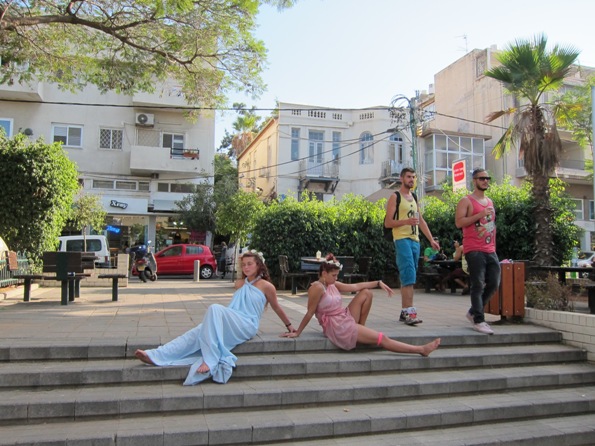
Art that takes risks, makes no compromises, and communicates directly with the audience without condescension – these are the qualities that have made me a long-time fan of Nisui Kelim (Testing Tools), a platform for multi-disciplinary experimental art. Encompassing visual arts, performance, installation, music and almost anything else you can imagine, the program took place for several years under the artistic direction of Amitay Yaish and curator Moran Shuv at Bikurei Ha’Itim in Tel Aviv. Actor/director Gil Alon is entering his second year as the Artistic Director with Arie Berkowitz as curator for visual art. The commitment to artistic experimentation remains as strong as ever this year, with one difference: Nisui Kelim has had a change of venue.
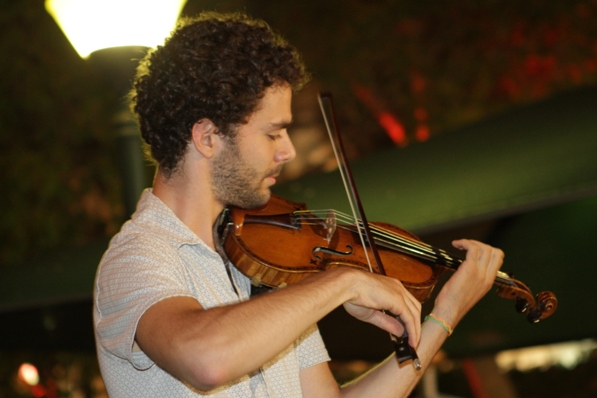
The festival, which took place from August 16 – 18, 2011, expanded its scope with installations and performance taking place at Beit Tami, and the visual arts on exhibit at Mazeh 9. In addition, this year for the first time, Nisui Kelim performances will head north in September for the launch of the new Zikit Cultural Center, directed by Pablo Ariel, located in the Tefen Industrial area.
Beit Tami, a community center in the heart of busy, trendy Shenkin Street, is an excellent choice for this kind of program. Teenagers, artists and tourists rub shoulders with longtime neighborhood residents on this street that appears to have survived its gentrification more or less intact, despite more than the occasional nod to gross commercialism. Beit Tami enjoys a privileged place in Shenkin Garden, making it truly a community center, conceptually and geographically.
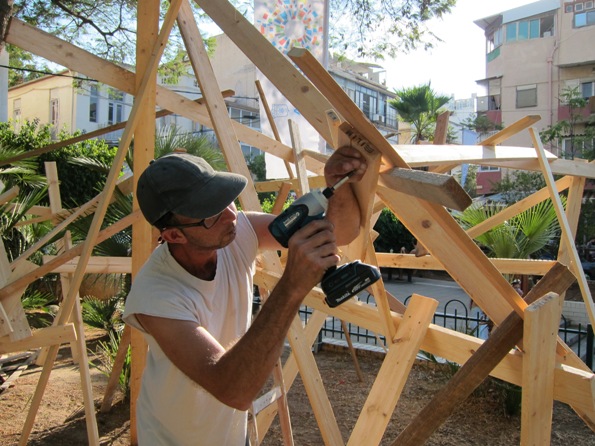
With Nisui Kelim taking place in and around the building, the festival is open to the neighborhood, attracting a diverse audience of all ages, from die-hard fringe-art aficionados to the random pedestrian. Walking into the garden I first encountered Avner Eitan working on a site specific wood sculpture. Eitan said that he is “interested in working in the public space, less concerned with the outcome than the process,” explaining that the process is one of constant building and dismantling, he concluded, “we’ll see what happens today, I don’t really know.”
It is that feeling of the unexpected that I enjoy most about Nisui Kelim. It’s a long strange trip through different art forms and anything can happen, including a performance that falls flat. The performances are works in progress, the development of a creative idea that has reached the point when it is ready to be seen. In the festival’s history, some projects, such as Naomi Yoeli’s Aunt Frida, or Richard II created by Oded Littman and Zvi Sahar, have developed into full length works that have garnered critical acclaim. Yet I come to Nisui Kelim, not as a critical observer, but as a participant in a shared experience.
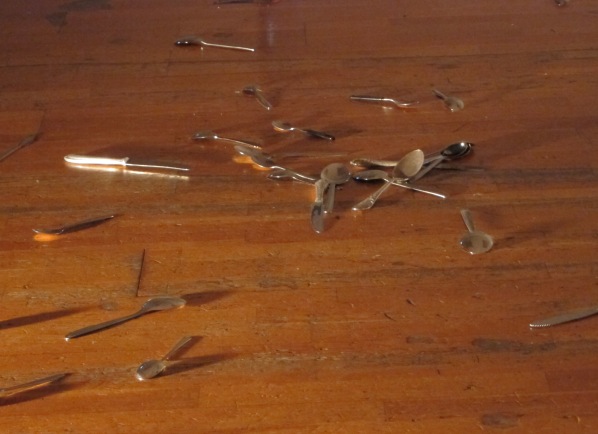
The abundance of video, dance, theatre and other performance works make it impossible to see everything, or even a representative sample. My random sample started off with a crash as silverware went flying out of a closet-like construction in Kamer 10 by Andrijana Lubina. Dori Engel and Yuval Rappaport performed movement with text (written by Engel, Rappaport and Lisa Vereertbrugghen) creating a bizarre portrait of childhood juxtaposed with violence. Engel recited a litany of different groups (experimental artists, homeless) crawling through the silverware strewn on the floor and then going back to the starting point to repeat the cycle, while Rappaport stood apart, in another corner of the room and moved in intense physical discomfort, as if in conflict with his own body. Flying ping pong balls, the “duck and cover” song, and a recipe for chocolate dessert – “chocolate sprinkles like black snow” – recited by Rappaport with rising intensity – “I have a birthday… I was a good boy… I deserve it even if I wasn’t a good boy” – while Engel swims on the floor equipped with goggles and occasionally encountering a squeaky toy with his back, made this a darkly delicious opening to my evening.
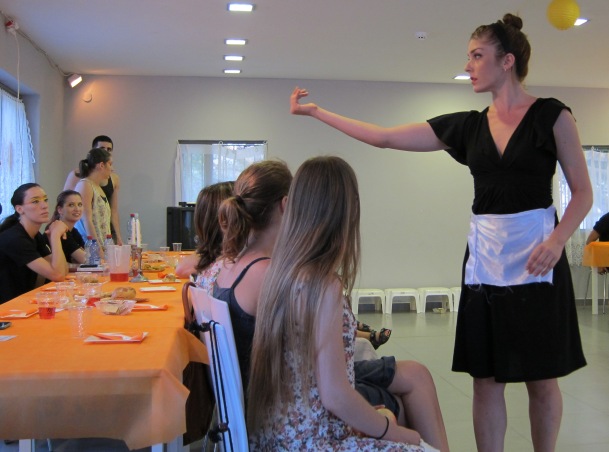
Next on my menu was “HaArucha” – the meal, choreographed by Noa Sagie. A festive family meal with two long tables set facing one another in the foyer; the audience was instructed to sit at the tables, with the rather interactive performance taking place primarily in the area between. Family meals are always far more fun when the family in question is not your own, and one is free to laugh at their foibles. Dramatic music set the tone for family dynamics, power struggles and creative mayhem performed by four characters: a maid in crisp black and white with an imposing demeanor, a little girl in a big pink skirt, a male authority figure in black, and another woman who at first performed behind the scenes; seen dancing through the glass window of an inner office, then joined the action in the provisional dining room.
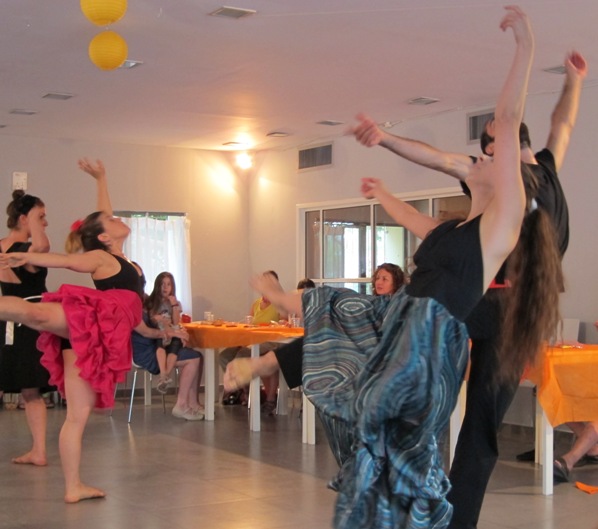
It was a wacky, yet aesthetic meal performed by four talented dancers which left me with an appetite for more.
Be-cause was described in the program as a work for one sighted dancer and one vision-impaired. As the two began their duet, sitting on two wooden benches, I could not discern from either their movement or facial expression, which of the two women could not see. The dance dealt with issues of vision and relationship to space, sound and time. The hand gestures were particularly eloquent, conveying an understanding of space in relationship to one’s own body and the body of another. The knowledge that I was watching someone move in a room without the ability to see the room or the objects therein, affected my own encounter with the work. I was far more attuned to sound, aware not only of the music, but the ways in which sound might be used to communicate movement in dance: a hand slap on a bench situates the dancer and can easily work as an indicator, informing a dance partner when and where to move.
![IMG_1814[1]because_amitehad](http://www.midnighteast.com/mag/wp-content/uploads/2011/08/IMG_18141because_amitehad.jpg)
One of the most dramatic moments in the duet occurs when the two dancers move loud and fast on the floor, dragging the benches with them. The freedom and power of movement expressed in this way by a dancer who cannot see has tremendous impact. Later, in discussing the performance, Hober-Rothschild pointed out that each carries the bench differently, with Hober-Rothschild pushing the bench ahead of her and Nahari dragging it behind her. Hober-Rothschild explained, “She was already there so she knows that she can drag the bench there.”
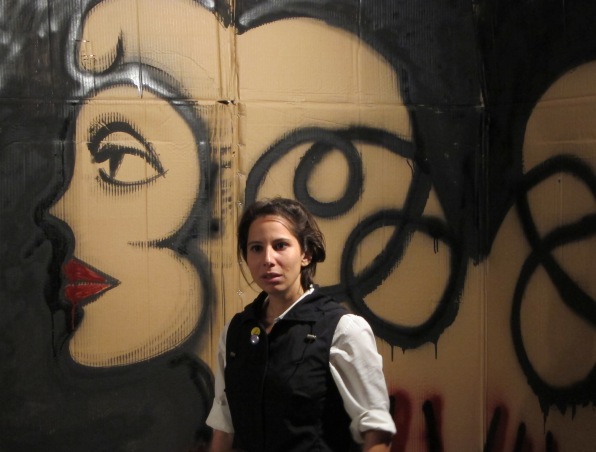
Talooy BeAtzmo (meaning literally – dependent on itself) is an engaging monodrama of young urban angst, directed and performed by Meirav Kupperberg, and written by Kupperberg with Eran Shadar. The set evokes the derelict chic of a small city apartment and the action begins with a young woman making the kind of pact you make with yourself when you are alone and desperate. Standing at a distance from the wastebasket she says: if it goes in, we are meant to be together. It’s a coming of age story of a young woman who moves to the big city with her best friend, where they do the things that young people with no money do in the city – go to legal aid for the free coffee in the waiting room, start a band, and have or simulate sex for money. The quirky protagonist, fragile, funny and all too self-aware is a sensitive and intelligent narrator of this tale that examines what we are willing to do for money and what we are willing to do in order to feel love, how we define our identity, how we define our limits, and how we define our freedom.
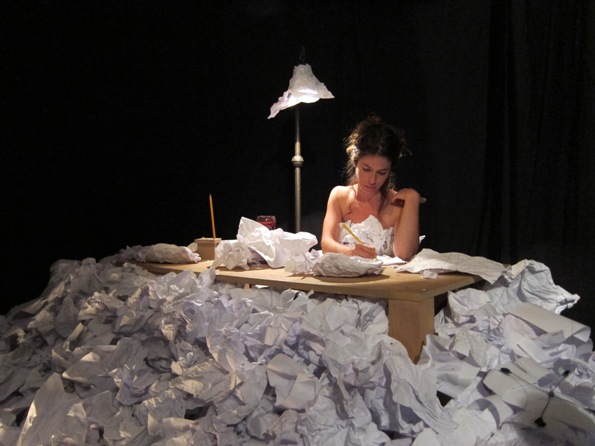
My evening closed with Op. 1 by Maayan Iungman, an intimate puppet theatre performance that is a work of spellbinding beauty. Working with paper and string Iungman creates an unforgettable experience of the imagination that just might have even the most cynical viewer floating on air, if only for a moment of wonder.
Kamer 10
Choreography: Andrijana Lubina
Performers: Dori Engel and Yuval Rappaport
Text: Dori Engel, Yuval Rappaport and Lisa Vereertbrugghen
HaArucha (The Meal)
Choreography: Noa Sagie
Creators: Mor Bar-Zakai, Yasmin Weiss, Nofar Levinger and Erez Tzemach
Be-Cause
Choreography: Michal Hober-Rothschild
Performers: Shelly Nahari and Michal Hober-Rothschild
Talooy BeAtzmo (Dependent on Itself)
Writing: Eran Shadar, Meirav Kupperberg
Direction and performance: Meirav Kupperberg
Artistic guidance: Michal Meishar, Boaz Barel
Choreography: Alik Niv
Set design: Yotam Kupperberg
Op. 1
Creator & performance: Maayan Iungman
Operator and fellow traveler: Karen Davidoff
Lighting design: Uri Rubinstein
Sound design: Dan Krager
Staff and fellow traveler: Gal Iungman

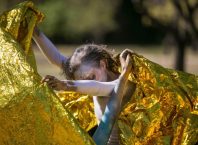
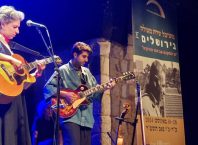

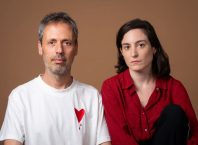
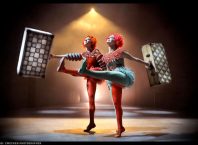
Las fotos muy bonitas, del texto no entiendo nada. Tengo que confesar mi ignorancia, espero que no me lo tome en cuenta. Podrian intentar que la rama hispanoparlante de Israel tuviera mas protagonismo, y nos enterariamos mas de todo. No compren armas a España para matar palestinos. Dejenlos que se recuperen un poco y veran como los aceptan. Mientras tanto me siento amiga de Israel, en la paz y la concordia.
Comments are closed.